Critical Analysis of Zara's Financial Reports and Conceptual Framework
VerifiedAdded on 2020/03/01
|11
|1577
|76
Report
AI Summary
This report provides a critical analysis of the general purpose financial reports of Zara, an Australian ASX top 100 listed corporation, to evaluate its compliance with the conceptual accounting framework developed by the IASB. The report examines Zara's financial statements, focusing on key areas such as depreciation, assets and liabilities, derivatives, leases, and segment reporting. The analysis demonstrates how Zara adheres to IFRS standards, including the use of straight-line depreciation, fair value measurement for assets and liabilities, and detailed disclosures on derivatives and leases. The report highlights the company's compliance with the conceptual accounting framework, emphasizing the relevance, reliability, comparability, and understandability of its financial reporting. The conclusion summarizes the overall compliance of the Inditex Group, Zara's parent company, with the principles of the conceptual framework and the IFRS standards.
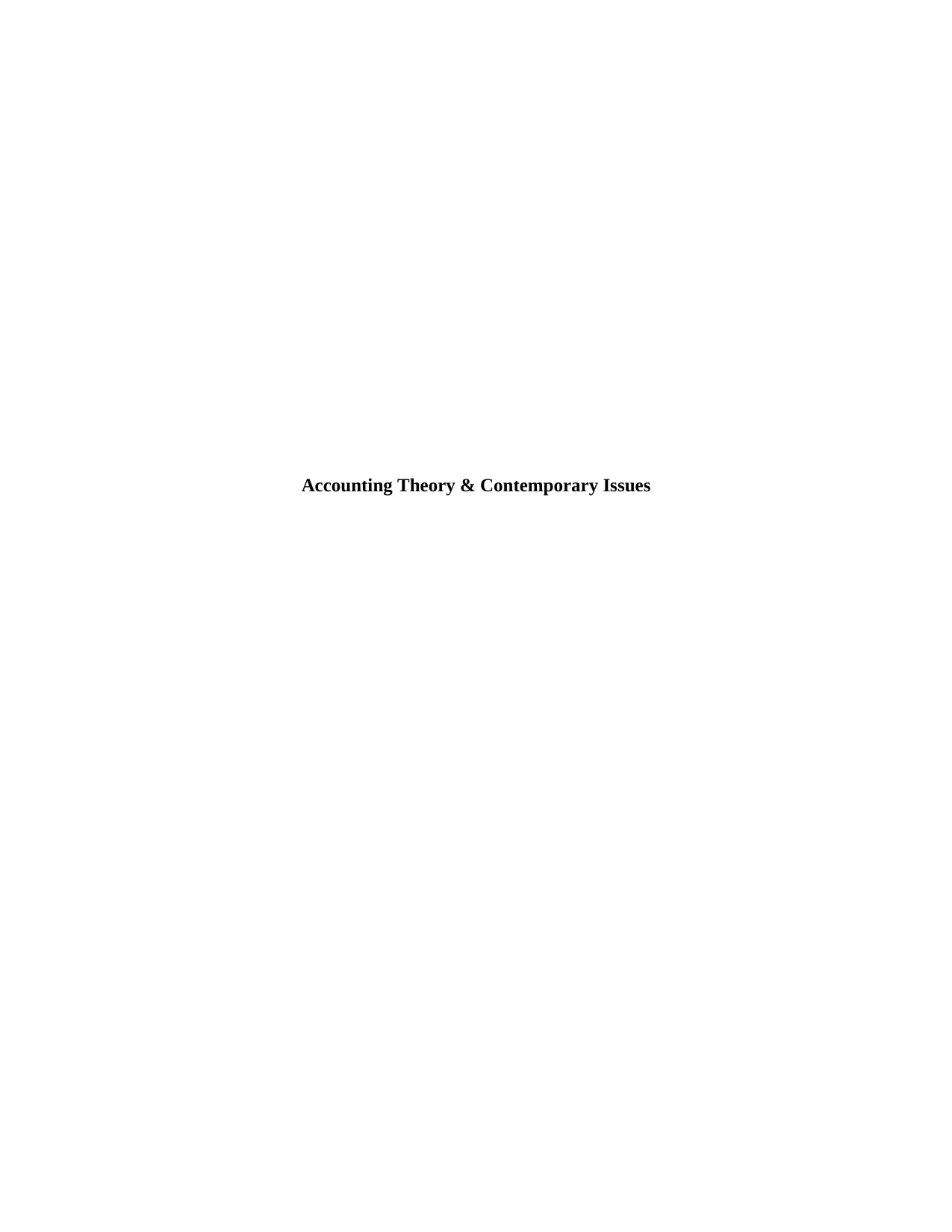
Accounting Theory & Contemporary Issues
Paraphrase This Document
Need a fresh take? Get an instant paraphrase of this document with our AI Paraphraser
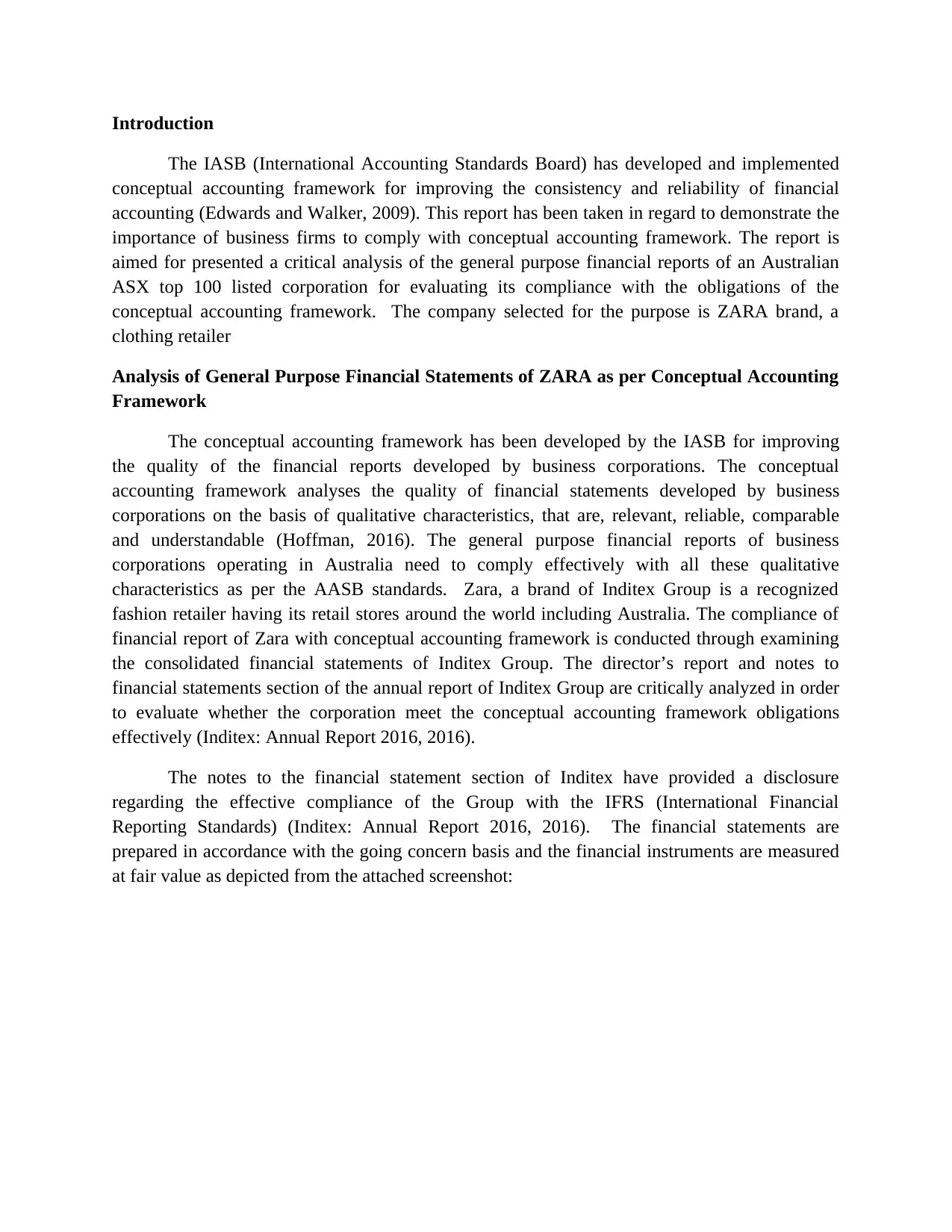
Introduction
The IASB (International Accounting Standards Board) has developed and implemented
conceptual accounting framework for improving the consistency and reliability of financial
accounting (Edwards and Walker, 2009). This report has been taken in regard to demonstrate the
importance of business firms to comply with conceptual accounting framework. The report is
aimed for presented a critical analysis of the general purpose financial reports of an Australian
ASX top 100 listed corporation for evaluating its compliance with the obligations of the
conceptual accounting framework. The company selected for the purpose is ZARA brand, a
clothing retailer
Analysis of General Purpose Financial Statements of ZARA as per Conceptual Accounting
Framework
The conceptual accounting framework has been developed by the IASB for improving
the quality of the financial reports developed by business corporations. The conceptual
accounting framework analyses the quality of financial statements developed by business
corporations on the basis of qualitative characteristics, that are, relevant, reliable, comparable
and understandable (Hoffman, 2016). The general purpose financial reports of business
corporations operating in Australia need to comply effectively with all these qualitative
characteristics as per the AASB standards. Zara, a brand of Inditex Group is a recognized
fashion retailer having its retail stores around the world including Australia. The compliance of
financial report of Zara with conceptual accounting framework is conducted through examining
the consolidated financial statements of Inditex Group. The director’s report and notes to
financial statements section of the annual report of Inditex Group are critically analyzed in order
to evaluate whether the corporation meet the conceptual accounting framework obligations
effectively (Inditex: Annual Report 2016, 2016).
The notes to the financial statement section of Inditex have provided a disclosure
regarding the effective compliance of the Group with the IFRS (International Financial
Reporting Standards) (Inditex: Annual Report 2016, 2016). The financial statements are
prepared in accordance with the going concern basis and the financial instruments are measured
at fair value as depicted from the attached screenshot:
The IASB (International Accounting Standards Board) has developed and implemented
conceptual accounting framework for improving the consistency and reliability of financial
accounting (Edwards and Walker, 2009). This report has been taken in regard to demonstrate the
importance of business firms to comply with conceptual accounting framework. The report is
aimed for presented a critical analysis of the general purpose financial reports of an Australian
ASX top 100 listed corporation for evaluating its compliance with the obligations of the
conceptual accounting framework. The company selected for the purpose is ZARA brand, a
clothing retailer
Analysis of General Purpose Financial Statements of ZARA as per Conceptual Accounting
Framework
The conceptual accounting framework has been developed by the IASB for improving
the quality of the financial reports developed by business corporations. The conceptual
accounting framework analyses the quality of financial statements developed by business
corporations on the basis of qualitative characteristics, that are, relevant, reliable, comparable
and understandable (Hoffman, 2016). The general purpose financial reports of business
corporations operating in Australia need to comply effectively with all these qualitative
characteristics as per the AASB standards. Zara, a brand of Inditex Group is a recognized
fashion retailer having its retail stores around the world including Australia. The compliance of
financial report of Zara with conceptual accounting framework is conducted through examining
the consolidated financial statements of Inditex Group. The director’s report and notes to
financial statements section of the annual report of Inditex Group are critically analyzed in order
to evaluate whether the corporation meet the conceptual accounting framework obligations
effectively (Inditex: Annual Report 2016, 2016).
The notes to the financial statement section of Inditex have provided a disclosure
regarding the effective compliance of the Group with the IFRS (International Financial
Reporting Standards) (Inditex: Annual Report 2016, 2016). The financial statements are
prepared in accordance with the going concern basis and the financial instruments are measured
at fair value as depicted from the attached screenshot:
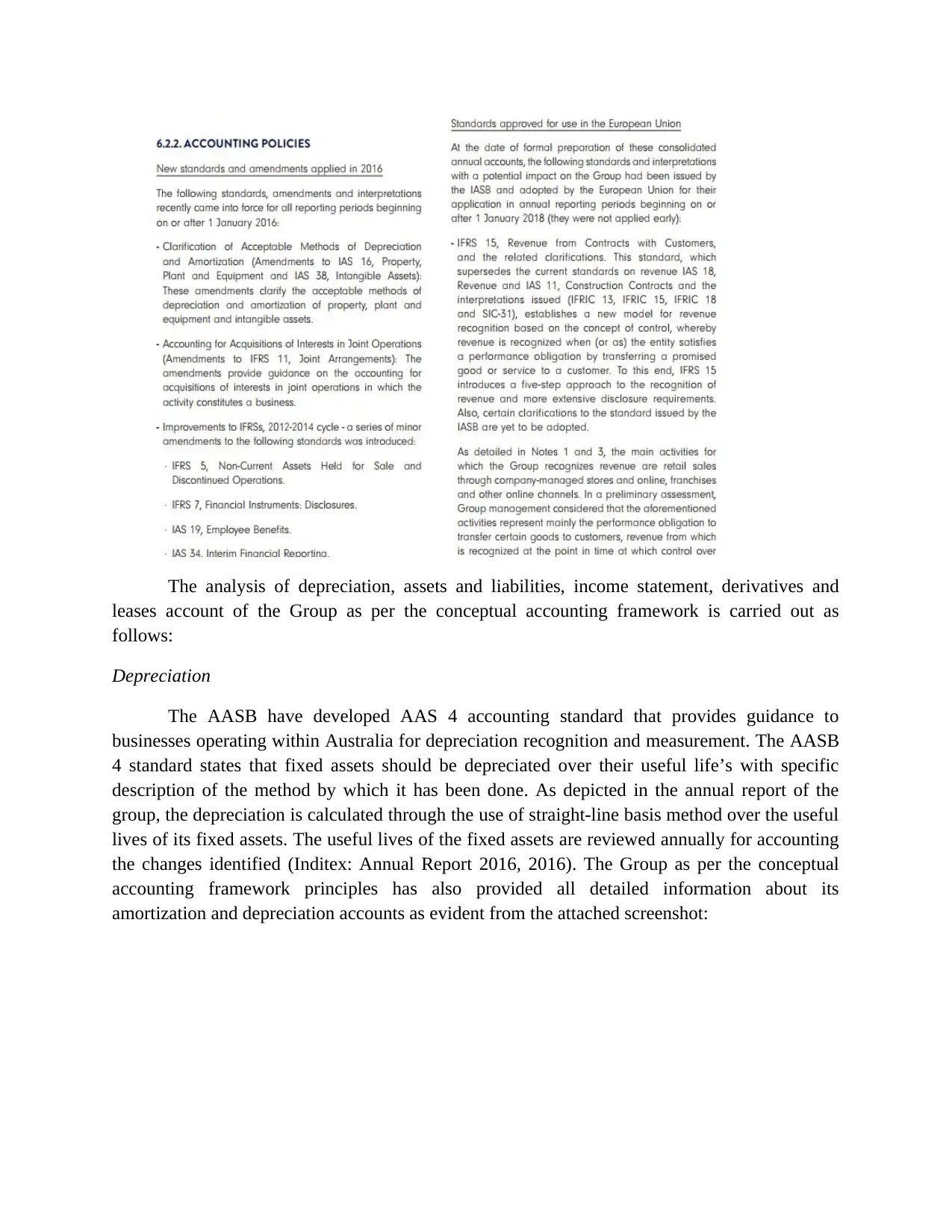
The analysis of depreciation, assets and liabilities, income statement, derivatives and
leases account of the Group as per the conceptual accounting framework is carried out as
follows:
Depreciation
The AASB have developed AAS 4 accounting standard that provides guidance to
businesses operating within Australia for depreciation recognition and measurement. The AASB
4 standard states that fixed assets should be depreciated over their useful life’s with specific
description of the method by which it has been done. As depicted in the annual report of the
group, the depreciation is calculated through the use of straight-line basis method over the useful
lives of its fixed assets. The useful lives of the fixed assets are reviewed annually for accounting
the changes identified (Inditex: Annual Report 2016, 2016). The Group as per the conceptual
accounting framework principles has also provided all detailed information about its
amortization and depreciation accounts as evident from the attached screenshot:
leases account of the Group as per the conceptual accounting framework is carried out as
follows:
Depreciation
The AASB have developed AAS 4 accounting standard that provides guidance to
businesses operating within Australia for depreciation recognition and measurement. The AASB
4 standard states that fixed assets should be depreciated over their useful life’s with specific
description of the method by which it has been done. As depicted in the annual report of the
group, the depreciation is calculated through the use of straight-line basis method over the useful
lives of its fixed assets. The useful lives of the fixed assets are reviewed annually for accounting
the changes identified (Inditex: Annual Report 2016, 2016). The Group as per the conceptual
accounting framework principles has also provided all detailed information about its
amortization and depreciation accounts as evident from the attached screenshot:
⊘ This is a preview!⊘
Do you want full access?
Subscribe today to unlock all pages.

Trusted by 1+ million students worldwide
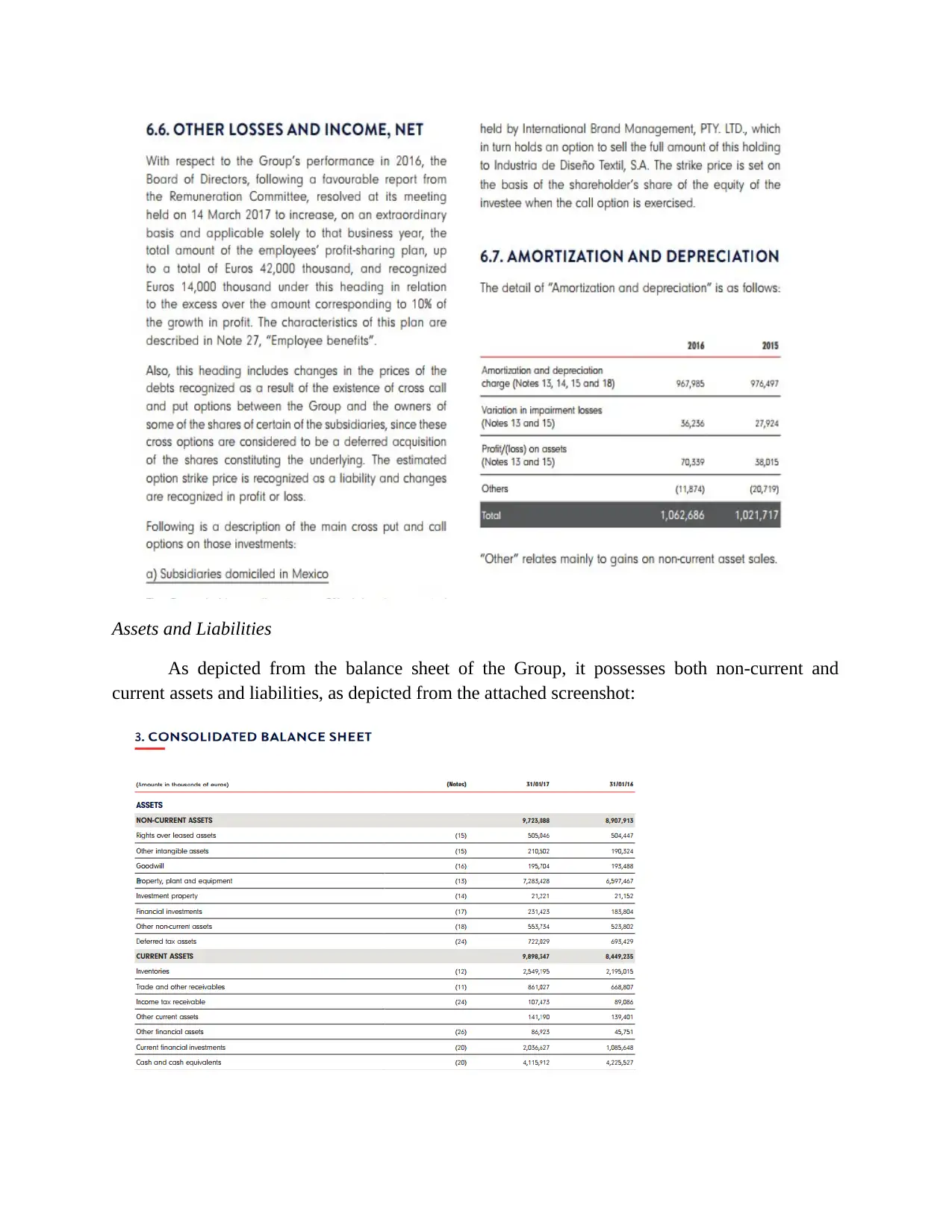
Assets and Liabilities
As depicted from the balance sheet of the Group, it possesses both non-current and
current assets and liabilities, as depicted from the attached screenshot:
As depicted from the balance sheet of the Group, it possesses both non-current and
current assets and liabilities, as depicted from the attached screenshot:
Paraphrase This Document
Need a fresh take? Get an instant paraphrase of this document with our AI Paraphraser

The consolidated balance sheet of the Group has classifies assets and liabilities into
current and non-current sections. The assets and liabilities are included under current when they
are estimated to be realized within 12 months otherwise are included under non-current items
(Measuring Assets and Liabilities, 2007). The cost of assets and liabilities is realized at fair value
as per the IFRS 13 accounting standard through the use of cost approach valuation technique.
The Group as per the IFRS standards also reviews the carrying amount of its tangible and
intangible assets for determining whether the assets suffer from any impairment value. The group
as per the IFRS standard in the cause of nay impairment estimates the recoverable amount of the
asset for determining the loss incurred due to impairment (IFRS 13 Fair Value Measurement,
2010). The company as per the conceptual accounting framework has also disclosed all the
relevant information in its notes to financial statements section about the accounting policies
adopted for maintaining its assets and liabilities account. The method adopted for measuring the
cost of all the assets and liabilities of the Group are detailed in the notes to financial statements
section (Inditex: Annual Report 2016, 2016).
Derivatives
The notes to the financial statements section of the Group has detailed all the information
related to the use of derivatives and hedging operations. As per the IFRS standards, the
derivatives used by the Group for hedging against the future contracts in foreign currencies are
recognized at the fair value (IFRS 13 Fair Value Measurement, 2010). The foreign currency
hedges in relation to the forecast transactions are recognized under the cash flow hedges. The
gain or losses realized from the measurement of hedging instrument at the fair value is
current and non-current sections. The assets and liabilities are included under current when they
are estimated to be realized within 12 months otherwise are included under non-current items
(Measuring Assets and Liabilities, 2007). The cost of assets and liabilities is realized at fair value
as per the IFRS 13 accounting standard through the use of cost approach valuation technique.
The Group as per the IFRS standards also reviews the carrying amount of its tangible and
intangible assets for determining whether the assets suffer from any impairment value. The group
as per the IFRS standard in the cause of nay impairment estimates the recoverable amount of the
asset for determining the loss incurred due to impairment (IFRS 13 Fair Value Measurement,
2010). The company as per the conceptual accounting framework has also disclosed all the
relevant information in its notes to financial statements section about the accounting policies
adopted for maintaining its assets and liabilities account. The method adopted for measuring the
cost of all the assets and liabilities of the Group are detailed in the notes to financial statements
section (Inditex: Annual Report 2016, 2016).
Derivatives
The notes to the financial statements section of the Group has detailed all the information
related to the use of derivatives and hedging operations. As per the IFRS standards, the
derivatives used by the Group for hedging against the future contracts in foreign currencies are
recognized at the fair value (IFRS 13 Fair Value Measurement, 2010). The foreign currency
hedges in relation to the forecast transactions are recognized under the cash flow hedges. The
gain or losses realized from the measurement of hedging instrument at the fair value is
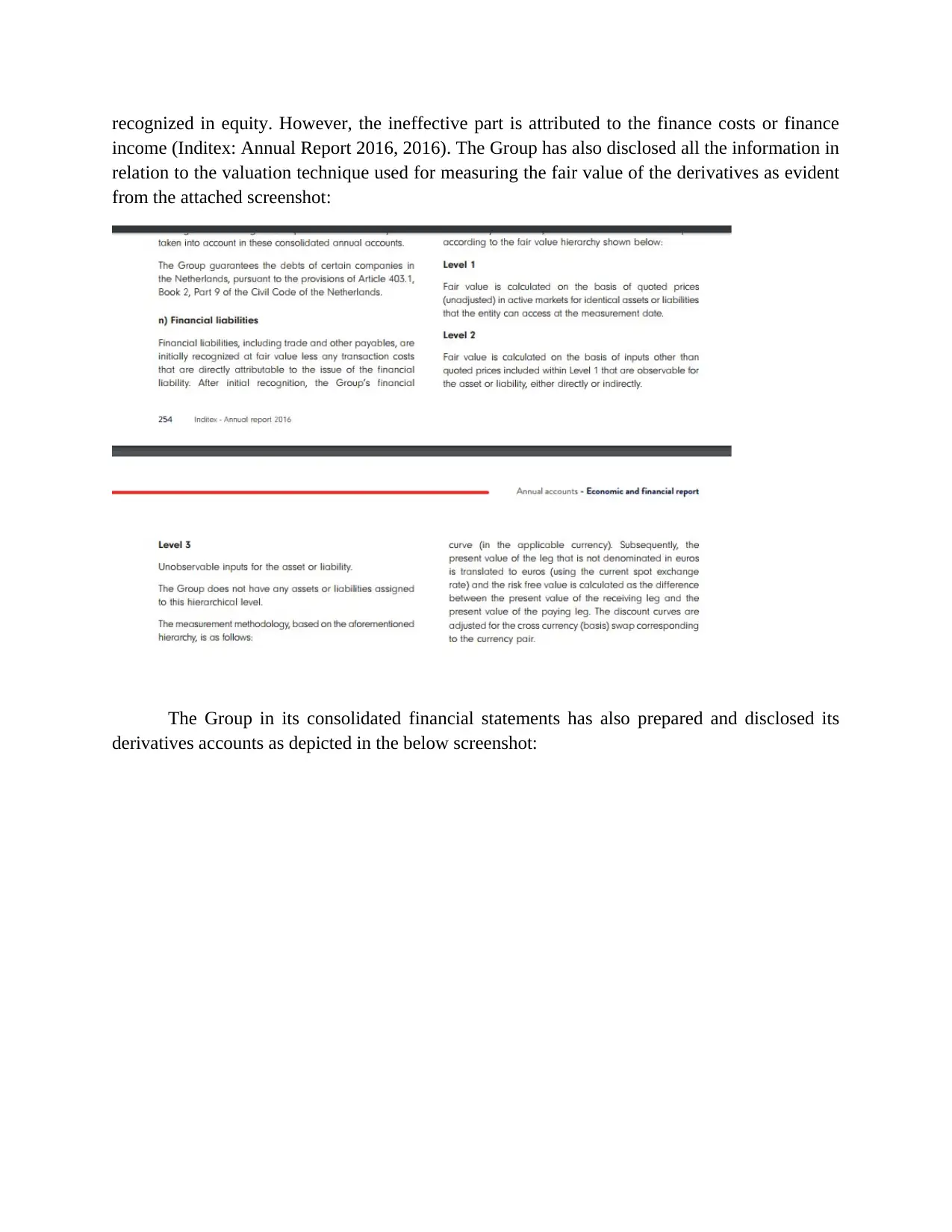
recognized in equity. However, the ineffective part is attributed to the finance costs or finance
income (Inditex: Annual Report 2016, 2016). The Group has also disclosed all the information in
relation to the valuation technique used for measuring the fair value of the derivatives as evident
from the attached screenshot:
The Group in its consolidated financial statements has also prepared and disclosed its
derivatives accounts as depicted in the below screenshot:
income (Inditex: Annual Report 2016, 2016). The Group has also disclosed all the information in
relation to the valuation technique used for measuring the fair value of the derivatives as evident
from the attached screenshot:
The Group in its consolidated financial statements has also prepared and disclosed its
derivatives accounts as depicted in the below screenshot:
⊘ This is a preview!⊘
Do you want full access?
Subscribe today to unlock all pages.

Trusted by 1+ million students worldwide
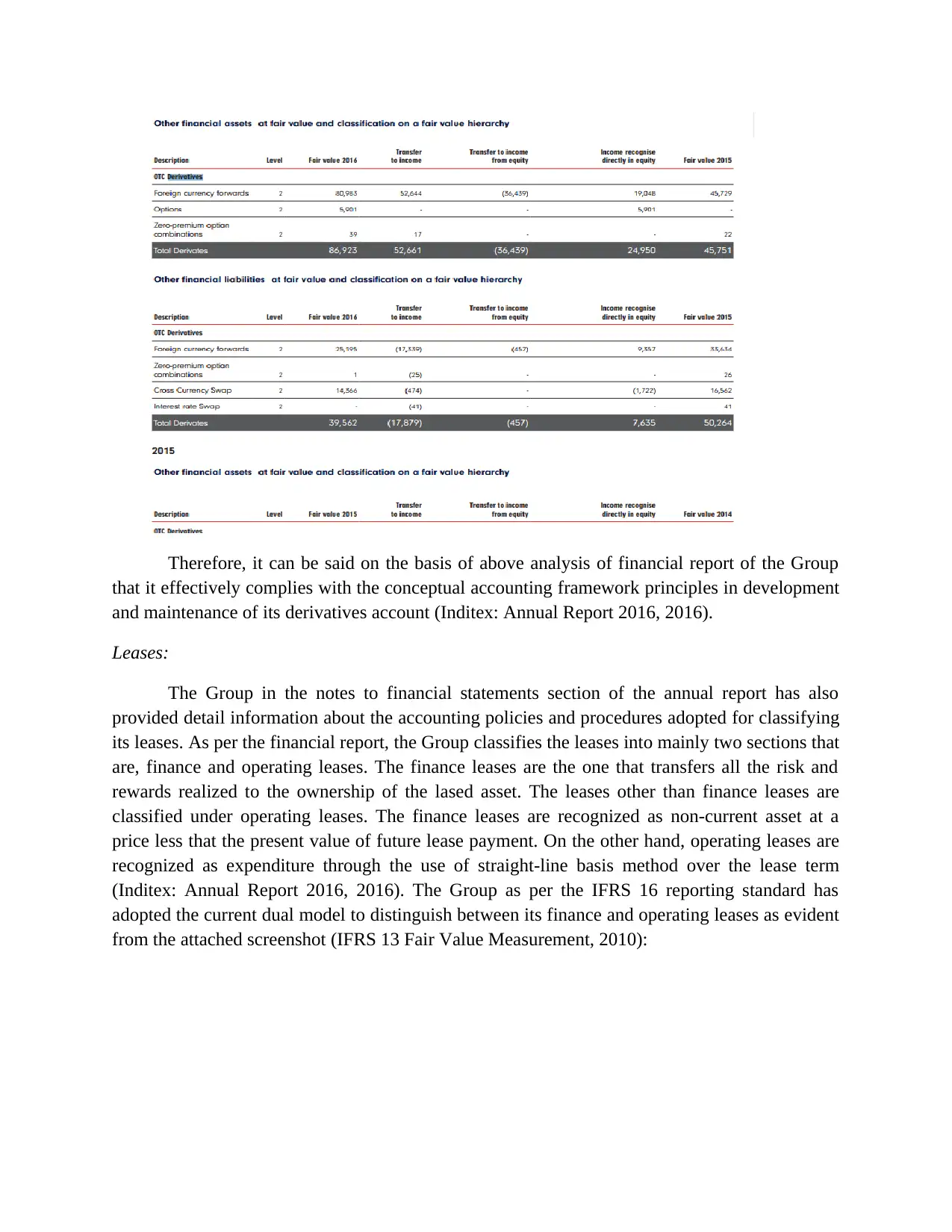
Therefore, it can be said on the basis of above analysis of financial report of the Group
that it effectively complies with the conceptual accounting framework principles in development
and maintenance of its derivatives account (Inditex: Annual Report 2016, 2016).
Leases:
The Group in the notes to financial statements section of the annual report has also
provided detail information about the accounting policies and procedures adopted for classifying
its leases. As per the financial report, the Group classifies the leases into mainly two sections that
are, finance and operating leases. The finance leases are the one that transfers all the risk and
rewards realized to the ownership of the lased asset. The leases other than finance leases are
classified under operating leases. The finance leases are recognized as non-current asset at a
price less that the present value of future lease payment. On the other hand, operating leases are
recognized as expenditure through the use of straight-line basis method over the lease term
(Inditex: Annual Report 2016, 2016). The Group as per the IFRS 16 reporting standard has
adopted the current dual model to distinguish between its finance and operating leases as evident
from the attached screenshot (IFRS 13 Fair Value Measurement, 2010):
that it effectively complies with the conceptual accounting framework principles in development
and maintenance of its derivatives account (Inditex: Annual Report 2016, 2016).
Leases:
The Group in the notes to financial statements section of the annual report has also
provided detail information about the accounting policies and procedures adopted for classifying
its leases. As per the financial report, the Group classifies the leases into mainly two sections that
are, finance and operating leases. The finance leases are the one that transfers all the risk and
rewards realized to the ownership of the lased asset. The leases other than finance leases are
classified under operating leases. The finance leases are recognized as non-current asset at a
price less that the present value of future lease payment. On the other hand, operating leases are
recognized as expenditure through the use of straight-line basis method over the lease term
(Inditex: Annual Report 2016, 2016). The Group as per the IFRS 16 reporting standard has
adopted the current dual model to distinguish between its finance and operating leases as evident
from the attached screenshot (IFRS 13 Fair Value Measurement, 2010):
Paraphrase This Document
Need a fresh take? Get an instant paraphrase of this document with our AI Paraphraser
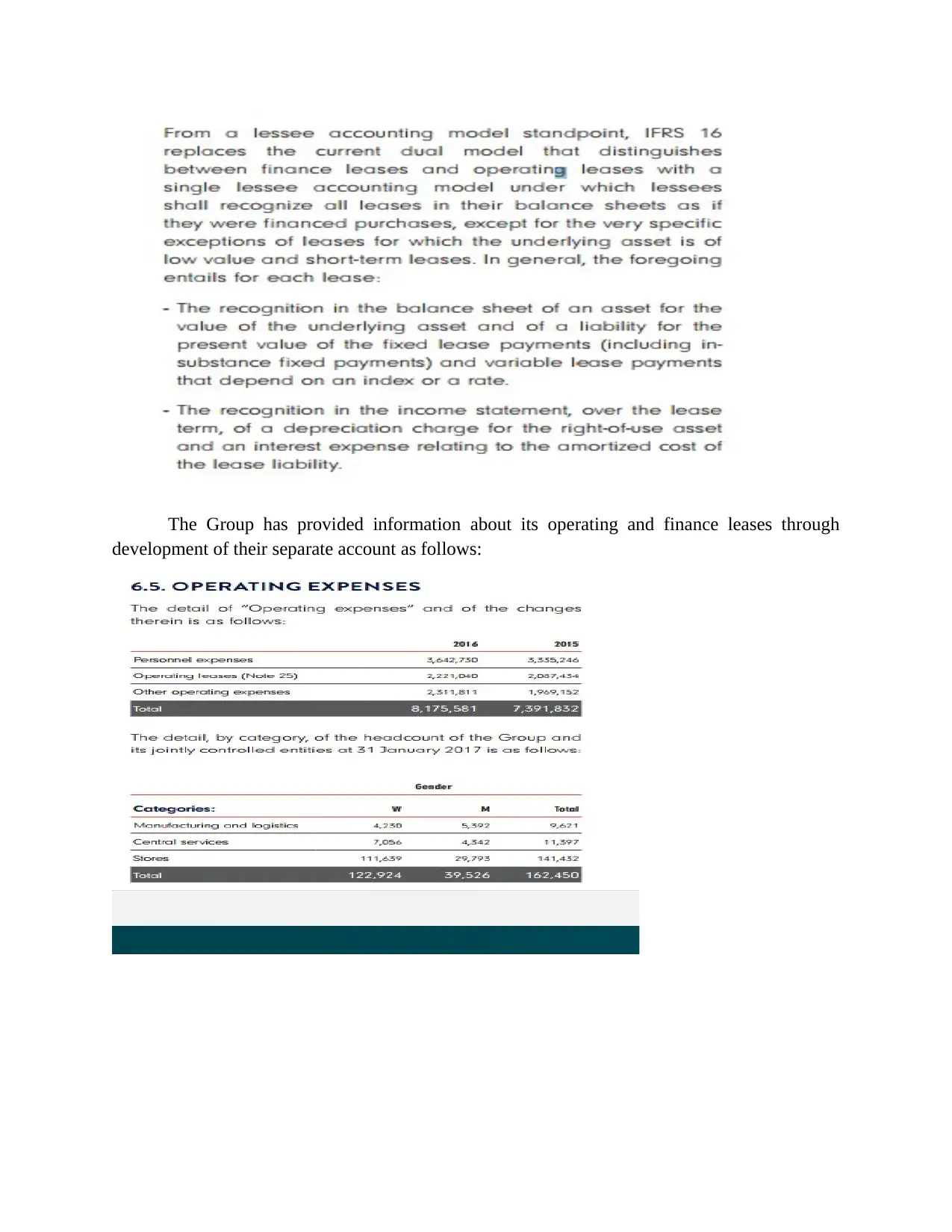
The Group has provided information about its operating and finance leases through
development of their separate account as follows:
development of their separate account as follows:
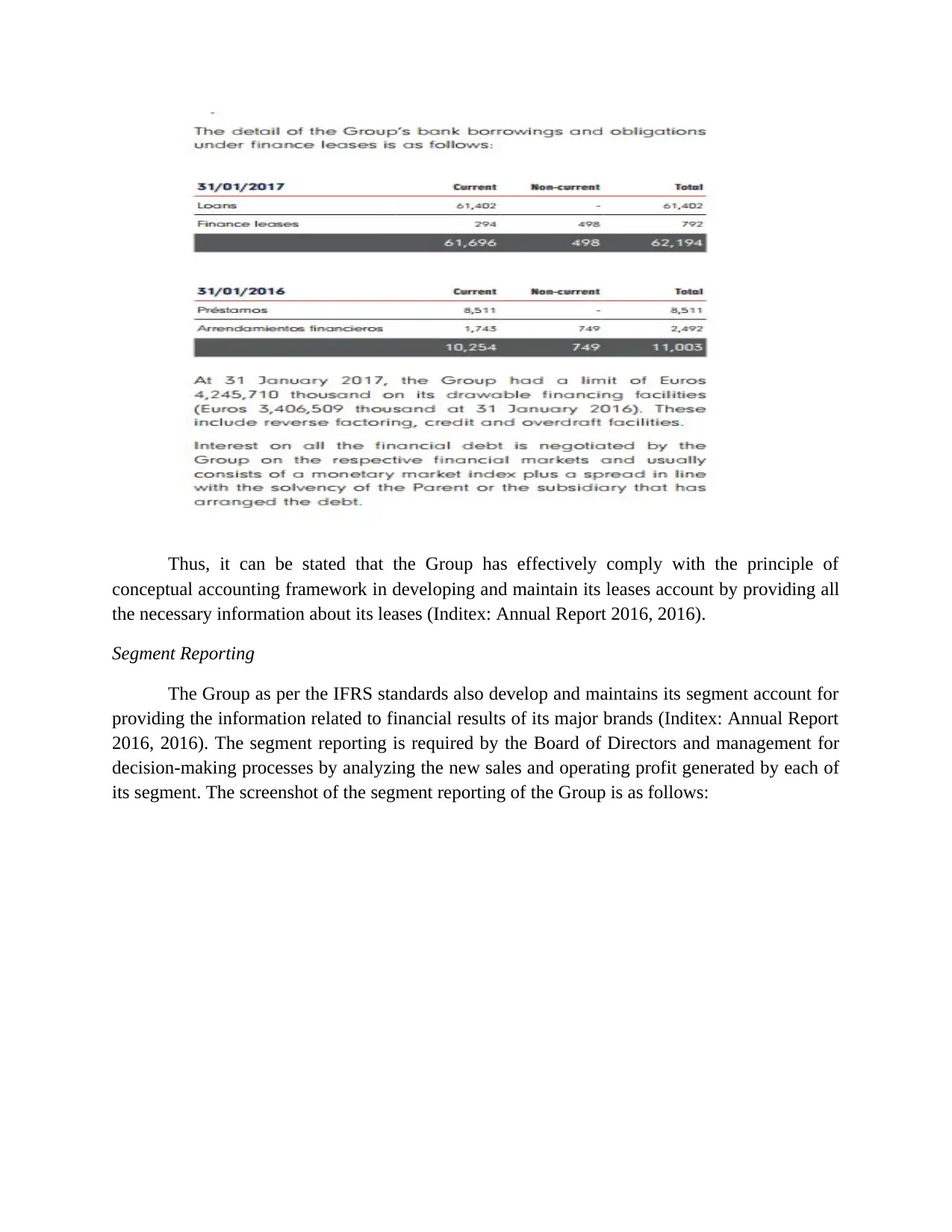
Thus, it can be stated that the Group has effectively comply with the principle of
conceptual accounting framework in developing and maintain its leases account by providing all
the necessary information about its leases (Inditex: Annual Report 2016, 2016).
Segment Reporting
The Group as per the IFRS standards also develop and maintains its segment account for
providing the information related to financial results of its major brands (Inditex: Annual Report
2016, 2016). The segment reporting is required by the Board of Directors and management for
decision-making processes by analyzing the new sales and operating profit generated by each of
its segment. The screenshot of the segment reporting of the Group is as follows:
conceptual accounting framework in developing and maintain its leases account by providing all
the necessary information about its leases (Inditex: Annual Report 2016, 2016).
Segment Reporting
The Group as per the IFRS standards also develop and maintains its segment account for
providing the information related to financial results of its major brands (Inditex: Annual Report
2016, 2016). The segment reporting is required by the Board of Directors and management for
decision-making processes by analyzing the new sales and operating profit generated by each of
its segment. The screenshot of the segment reporting of the Group is as follows:
⊘ This is a preview!⊘
Do you want full access?
Subscribe today to unlock all pages.

Trusted by 1+ million students worldwide
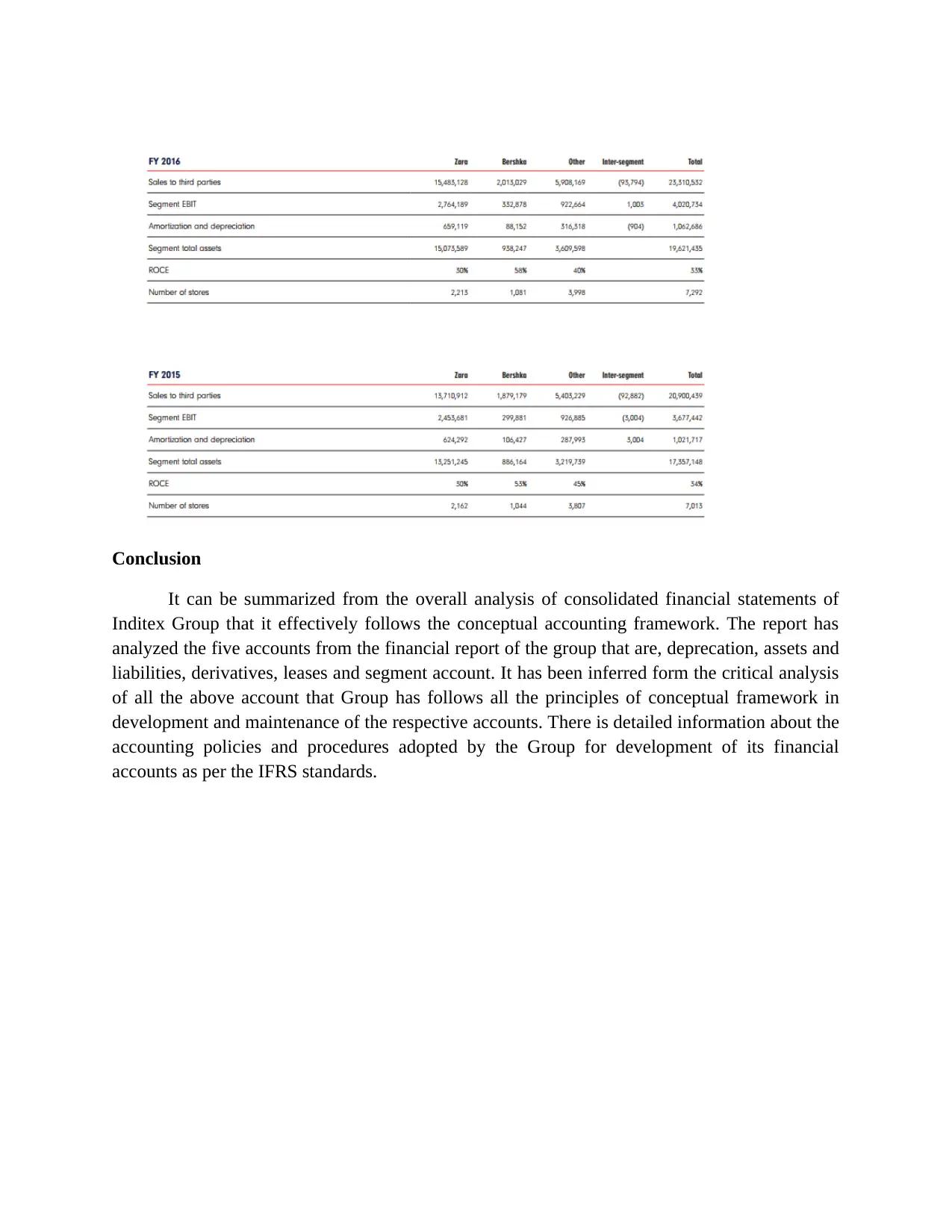
Conclusion
It can be summarized from the overall analysis of consolidated financial statements of
Inditex Group that it effectively follows the conceptual accounting framework. The report has
analyzed the five accounts from the financial report of the group that are, deprecation, assets and
liabilities, derivatives, leases and segment account. It has been inferred form the critical analysis
of all the above account that Group has follows all the principles of conceptual framework in
development and maintenance of the respective accounts. There is detailed information about the
accounting policies and procedures adopted by the Group for development of its financial
accounts as per the IFRS standards.
It can be summarized from the overall analysis of consolidated financial statements of
Inditex Group that it effectively follows the conceptual accounting framework. The report has
analyzed the five accounts from the financial report of the group that are, deprecation, assets and
liabilities, derivatives, leases and segment account. It has been inferred form the critical analysis
of all the above account that Group has follows all the principles of conceptual framework in
development and maintenance of the respective accounts. There is detailed information about the
accounting policies and procedures adopted by the Group for development of its financial
accounts as per the IFRS standards.
Paraphrase This Document
Need a fresh take? Get an instant paraphrase of this document with our AI Paraphraser
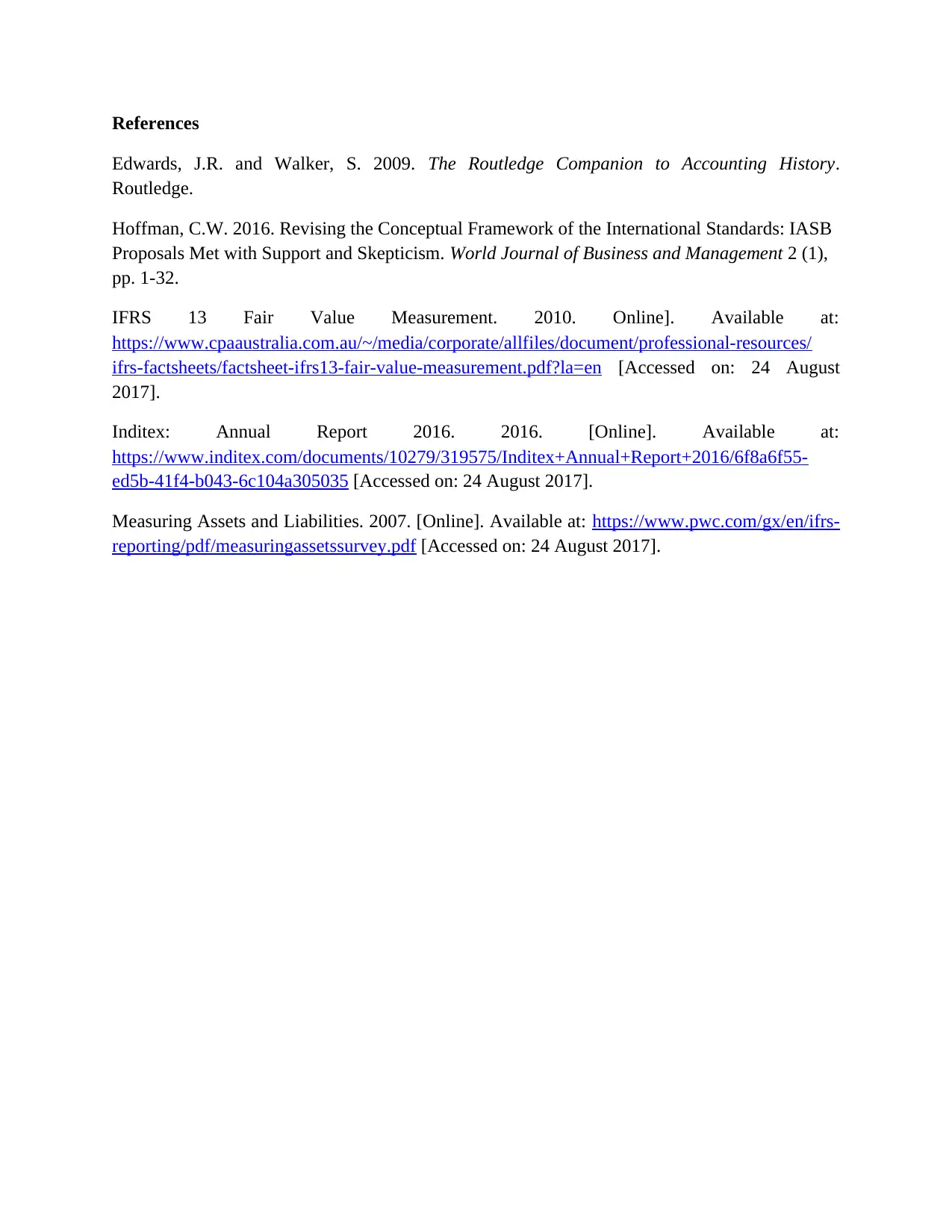
References
Edwards, J.R. and Walker, S. 2009. The Routledge Companion to Accounting History.
Routledge.
Hoffman, C.W. 2016. Revising the Conceptual Framework of the International Standards: IASB
Proposals Met with Support and Skepticism. World Journal of Business and Management 2 (1),
pp. 1-32.
IFRS 13 Fair Value Measurement. 2010. Online]. Available at:
https://www.cpaaustralia.com.au/~/media/corporate/allfiles/document/professional-resources/
ifrs-factsheets/factsheet-ifrs13-fair-value-measurement.pdf?la=en [Accessed on: 24 August
2017].
Inditex: Annual Report 2016. 2016. [Online]. Available at:
https://www.inditex.com/documents/10279/319575/Inditex+Annual+Report+2016/6f8a6f55-
ed5b-41f4-b043-6c104a305035 [Accessed on: 24 August 2017].
Measuring Assets and Liabilities. 2007. [Online]. Available at: https://www.pwc.com/gx/en/ifrs-
reporting/pdf/measuringassetssurvey.pdf [Accessed on: 24 August 2017].
Edwards, J.R. and Walker, S. 2009. The Routledge Companion to Accounting History.
Routledge.
Hoffman, C.W. 2016. Revising the Conceptual Framework of the International Standards: IASB
Proposals Met with Support and Skepticism. World Journal of Business and Management 2 (1),
pp. 1-32.
IFRS 13 Fair Value Measurement. 2010. Online]. Available at:
https://www.cpaaustralia.com.au/~/media/corporate/allfiles/document/professional-resources/
ifrs-factsheets/factsheet-ifrs13-fair-value-measurement.pdf?la=en [Accessed on: 24 August
2017].
Inditex: Annual Report 2016. 2016. [Online]. Available at:
https://www.inditex.com/documents/10279/319575/Inditex+Annual+Report+2016/6f8a6f55-
ed5b-41f4-b043-6c104a305035 [Accessed on: 24 August 2017].
Measuring Assets and Liabilities. 2007. [Online]. Available at: https://www.pwc.com/gx/en/ifrs-
reporting/pdf/measuringassetssurvey.pdf [Accessed on: 24 August 2017].
1 out of 11
Related Documents
Your All-in-One AI-Powered Toolkit for Academic Success.
+13062052269
info@desklib.com
Available 24*7 on WhatsApp / Email
![[object Object]](/_next/static/media/star-bottom.7253800d.svg)
Unlock your academic potential
Copyright © 2020–2025 A2Z Services. All Rights Reserved. Developed and managed by ZUCOL.





